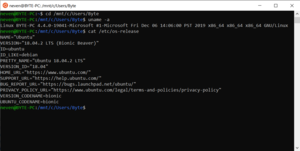
Back نظام ويندوز الفرعي للينكس Arabic Windows Subsystem for Linux Azerbaijani Windows Subsystem for Linux Catalan Windows Subsystem for Linux Czech Windows-Subsystem für Linux German Subsistema de Windows para Linux Spanish زیر سیستم ویندوز برای لینوکس Persian Windows Subsystem for Linux Finnish Windows Subsystem for Linux French WSL HE
This article has multiple issues. Please help improve it or discuss these issues on the talk page. (Learn how and when to remove these messages)
|
 | |
 Bash running on Windows 10 | |
| Other names | WSL |
|---|---|
| Developer(s) | Microsoft |
| Initial release | 2 August 2016 |
| Stable release | 2.3.26
/ 10 November 2024[1] |
| Repository | github |
| Operating system | Windows 10, Windows 10 LTSB/LTSC, Windows Server 2016, Windows Server 2019, Windows 11, Windows Server 2022, Windows Server 2025 |
| Predecessor | Windows Services for UNIX |
| Type | Compatibility layer, virtualization |
| License | Subsystem: Proprietary commercial software; Linux kernel: GNU GPLv2 (only) with some code under compatible GPL variants or under permissive licenses like BSD, MIT |
| Website | learn |
Windows Subsystem for Linux (WSL) is a feature of Microsoft Windows that allows for using a Linux environment without the need for a separate virtual machine or dual booting. WSL is installed by default in Windows 11.[2] In Windows 10, it can be installed either by joining the Windows Insider program or manually via Microsoft Store or Winget.[3]
The original version, WSL 1, differs significantly from the second major version, WSL 2. WSL 1 (released August 2, 2016), acted as a compatibility layer for running Linux binary executables (in ELF format) by implementing Linux system calls in the Windows kernel.[4] WSL 2 (announced May 2019[5]), introduced a real Linux kernel – a managed virtual machine (via Hyper-V technology) that implements the full Linux kernel. As a result, WSL 2 is compatible with more Linux binaries as not all system calls were implemented in WSL 1.[6]
Microsoft offers WSL for a variety of reasons. Microsoft envisions WSL as "a tool for developers – especially web developers and those who work on or with open source projects".[7] Microsoft also claims that "WSL requires fewer resources (CPU, memory, and storage) than a full virtual machine" (a common alternative for using Linux in Windows), while also allowing the use of both Windows and Linux tools on the same set of files.[7]
- ^ "Release 2.3.26 · microsoft/WSL". GitHub. 10 November 2024. Retrieved 12 November 2024.
- ^ June 2021, Darren Allan 23 (23 June 2021). "Windows 11 could seamlessly run graphical Linux apps". TechRadar. Retrieved 29 June 2021.
{{cite web}}: CS1 maint: numeric names: authors list (link) - ^ pokhrel, bishal (27 December 2023). "Install WSL on Windows 10 or 11". Droid Crafts.
- ^ Leeks, Stuart (2020). Windows Subsystem for Linux 2 (WSL 2) Tips, Tricks, and Techniques: Maximise Productivity of Your Windows 10 Development Machine with Custom Workflows and Configurations. Birmingham: Packt Publishing. pp. 18–19. ISBN 978-1-80056-352-0. OCLC 1202451000.
- ^ Craig Loewen (6 May 2019). "Announcing WSL 2". Windows Command Line Tools For Developers.
- ^ mscraigloewen. "About WSL 2". docs.microsoft.com.
- ^ a b Cite error: The named reference
ms-faqwas invoked but never defined (see the help page).